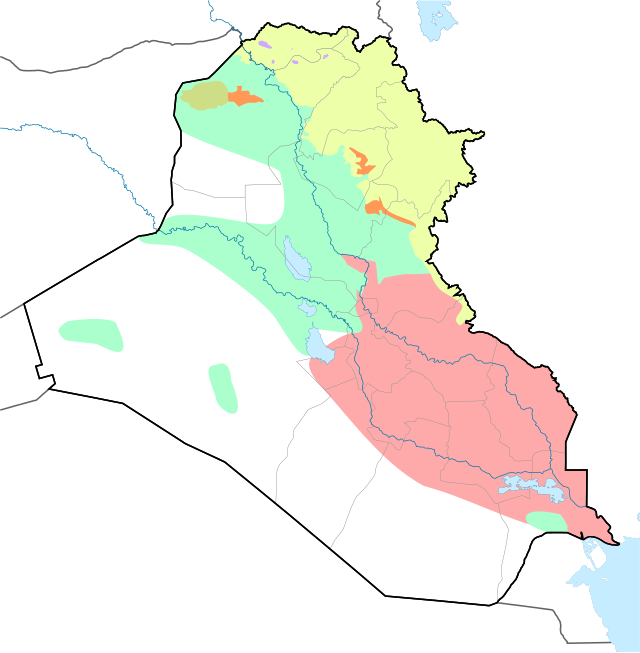Top Qs
Timeline
Chat
Perspective
Demographics of Iraq
From Wikipedia, the free encyclopedia
Remove ads
The Iraqi people (Arabic: العراقيون; Kurdish: گهلی عێراق; Syriac: ܥܡܐ ܥܝܪܩܝܐ) are people originating from the country of Iraq.[1]

Iraqi Arabs are the largest ethnic group in Iraq,[2] followed by Iraqi Kurds, then Iraqi Turkmen as the third largest ethnic group in the country.[3][4] Studies indicate that Mesopotamian Arabs, who make up the overwhelming majority of Iraq's population, are genetically distinct from other Arab populations in the Arabs of the Arabian peninsula.[5][6]
The most spoken languages are Mesopotamian Arabic, Kurdish, Assyrian Syriac and Iraqi Turkmen dialects. The percentages of the different ethno-religious groups of Iraq vary from source to source due to the lack of recent official data.
After several postponements, the latest national census was held on 20 and 21 November 2024, with a total number of 120,000 field researchers who executed the census in all governorates on the set date.[7] The detailed results, announced on 24 February 2025, showed that the Iraqi population had risen to 46,118,793, with 101 Male for every 100 Female. Named the ‘General Population and Housing Census’,[8] it did not include a questionnaire on ethnicity, and was specifically designed to provide official data for developmental and welfare purposes.[9][10][11]
Remove ads
Population
Summarize
Perspective
Structure of the population
Remove ads
Vital statistics
Summarize
Perspective
UN estimates (based on UN WPP Revision 2022)
View source data.
View source data.
View source data.
View source data.
Total fertility rate

|
5–6
4–5
3–4
2–3 |
Life expectancy at birth
Average life expectancy at birth of the total population.[20]

Remove ads
Ethnicity

Sunni Arabs
Shiite Arabs
Sunni Kurds
Assyrians
Yazidis
Turkmen
Iraq's dominant ethnic group is Arabs, who account for more than three-quarters of the population.
According to the CIA World Factbook, citing a 1987 Iraqi government estimate, the population of Iraq is formed of 75-80% Arabs (including Marsh Arabs) followed by 15-20% Kurds and other minorities form 5% of the country's population, including the Turkmen, Kaka'i, Bedouins, Roma, Assyrians, Circassians, Mandaeans, and Persians.[21]
However, the International Crisis Group points out that figures from the 1987 census, as well as the 1967, 1977, and 1997 censuses, "are all considered highly problematic, due to suspicions of regime manipulation" because Iraqi citizens were only allowed to indicate belonging to either the Arab or Kurdish ethnic groups;[22] consequently, this skewed the number of other ethnic minorities, such as Iraq's third largest ethnic group – the Turkmen.[22]
Languages
Arabic and Kurdish are the two official languages of Iraq. Arabic is taught across all schools in Iraq, however in the north the Kurdish language is the most spoken. Eastern Aramaic languages, such as Syriac and Mandaic are spoken, as well as the Iraqi Turkmen language, and various other indigenous languages.
Kurdish, including several dialects, is the second largest language and has regional language status in the north of the country. Aramaic, in antiquity spoken throughout the whole country, is now only spoken by the Assyrian minority, in distinct dialects that differ from church affiliation and geographic origin. The Iraqi Turkmen dialect is spoken in parts of northern Iraq, numerous languages of the Caucasus are also spoken by minorities, notably the Chechen community.
Remove ads
Religions
Summarize
Perspective
- Shia Islam (61.0%)
- Sunni Islam (34.0%)
- Christianity (2.00%)
- Other (3.00%)
The CIA World Factbook estimated in 2015 that between 95-98% of Iraqis followed Islam, with 61-64% being Shia and 29-34% being Sunni. Christianity accounted for 2%, and the rest (1-4%) practiced Yazidism, Mandaeism, and other religions.[23]
While there has been voluntary relocation of many Christian families to northern Iraq, recent reporting indicates that the overall Christian population may have dropped by as much as 50 percent since the fall of Saddam Hussein in 2003, with many fleeing to Syria, Jordan, and Lebanon (2010 estimate).[21] The percentage of Christians has fallen from 6% in 1991 or 1.5 million to about one third of this. Estimates say there are 500,000 Christians in Iraq.[24]
Nearly all Iraqi Kurds identify as Sunni Muslims. A 2014 survey in Iraq concluded that "98% of Kurds in Iraq identified themselves as Sunnis and only 2% identified as Shias".[25] The religious differences between Sunni Arabs and Sunni Kurds are small. While 98 percent of Shia Arabs believe that visiting the shrines of saints is acceptable, 71 percent of Sunni Arabs did and 59 percent of Sunni Kurds support this practice.[25] About 94 percent of the population in Iraqi Kurdistan is Muslim.[26]
Remove ads
See also
References
Further reading
External links
Wikiwand - on
Seamless Wikipedia browsing. On steroids.
Remove ads

